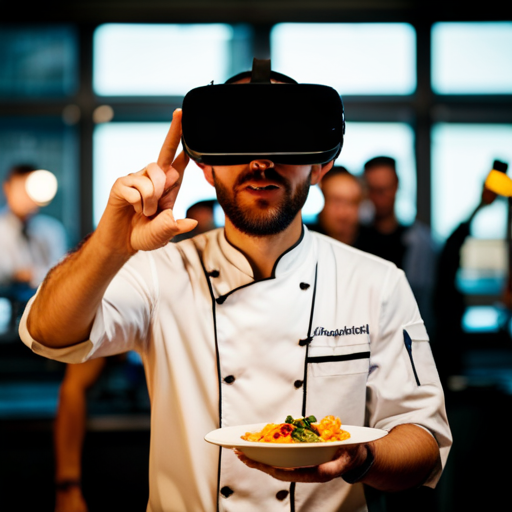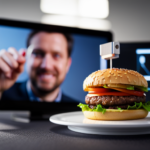Some may argue that virtual reality is purely for entertainment, but its impact on the culinary world is undeniable. This article explores the intersection of virtual reality and 3D printed food design, highlighting the evolution of culinary creativity, addressing dietary restrictions, and promoting sustainability.
As technology continues to revolutionize the way we approach food, virtual reality offers a unique platform for personalization and innovation in the realm of 3D printed food.
Evolution of 3D Printed Food Design
The evolution of 3D printed food design has been significantly influenced by advancements in technology and the exploration of novel ingredients. The integration of technology has revolutionized the way food is designed and prepared, allowing for intricate and customizable creations. 3D printed food design has gone beyond mere novelty, with the potential to address various challenges in the culinary world, such as food customization, personalized nutrition, and even addressing food security issues.
Technology integration has enabled the precise layering of ingredients, leading to the creation of complex and visually appealing food products. The use of specialized software and hardware has allowed chefs and food designers to push the boundaries of creativity, resulting in innovative culinary experiences.
Furthermore, the exploration of novel ingredients, including alternative proteins and plant-based materials, has expanded the possibilities for 3D printed food, catering to diverse dietary preferences and nutritional needs.
As technology continues to advance, 3D printed food design is poised to become more accessible and integrated into mainstream culinary practices, potentially revolutionizing the way food is prepared and consumed. This evolution underscores the transformative potential of 3D printed food design in shaping the future of gastronomy.
Virtual Reality Enhancing Culinary Creativity
Enhancing culinary creativity, virtual reality plays a pivotal role in revolutionizing the design process of 3D printed food. Virtual reality (VR) offers an immersive experience that stimulates the senses, inspiring chefs and food designers to push the boundaries of traditional culinary arts.
Here’s how VR enhances culinary creativity:
-
Immersive Experience: VR creates a simulated environment that transports users to different settings, allowing them to explore diverse culinary landscapes and ingredients from around the world. This immersive experience enables chefs to draw inspiration from various cultures and traditions, leading to the creation of innovative 3D printed dishes that blend different flavors and aesthetics.
-
Sensory Stimulation: By engaging multiple senses such as sight, smell, and taste, VR can provide a comprehensive sensory stimulation that helps chefs conceptualize and refine 3D printed food designs. This sensory input can evoke new ideas and approaches, enhancing the overall dining experience for consumers.
Through the combination of immersive experiences and sensory stimulation, VR empowers culinary artists to experiment with unconventional ingredients, textures, and presentation styles, ultimately fostering a new era of gastronomic innovation in the realm of 3D printed food.
Addressing Dietary Restrictions Through VR
Virtual reality technology offers a solution for addressing dietary restrictions in the design of 3D printed food. VR simulations can play a pivotal role in catering to individuals with food allergies or specific dietary needs. By using VR, individuals can have immersive experiences where they can visualize, customize, and even taste 3D printed food that aligns with their dietary requirements. This technology allows for a detailed examination of the ingredients and nutritional content of the food before it is printed, ensuring that it meets the necessary dietary restrictions.
Moreover, VR simulations can provide a platform for individuals to experiment with different ingredients and their combinations in a virtual space, allowing them to create personalized 3D printed meals that cater to their specific dietary needs. This not only empowers individuals with dietary restrictions but also opens up new avenues for culinary creativity and innovation in the 3D food printing industry.
Sustainability and Innovation in 3D Printed Food
An examination of the sustainability and innovation in 3D printed food reveals the potential for significant advancements in the culinary industry.
-
Sustainable Practices
-
Sustainable sourcing of ingredients: 3D printed food allows for the use of alternative ingredients such as algae or insects, which have a lower environmental impact than traditional animal agriculture.
-
Reduction of food waste: 3D printing enables the creation of customized food products, reducing the overproduction and food waste commonly associated with traditional manufacturing processes.
-
Food Safety
-
Controlled production environment: 3D printed food can be produced in a controlled and sterile environment, minimizing the risk of contamination and ensuring food safety.
-
Personalized nutrition: The ability to tailor the nutritional content of 3D printed food to individual needs can lead to safer consumption for individuals with specific dietary requirements.
These sustainable practices and focus on food safety not only align with current consumer trends but also address crucial challenges in the food industry.
As the technology continues to advance, the integration of sustainable practices and enhanced food safety measures in 3D printed food production will play a pivotal role in shaping the future of food manufacturing.
Personalization and Customization With VR
By integrating virtual reality (VR), designers are able to achieve unprecedented levels of personalization and customization in the 3D printed food industry.
VR enables personalized experiences by allowing users to interact with virtual environments and customize their food designs according to their preferences. This immersive technology provides a dynamic platform for consumers to engage with the creation process, making it possible to tailor food items to specific dietary needs, taste preferences, and nutritional requirements.
Through VR, individuals can visualize and interact with their virtual food creations, adjusting ingredients, textures, and flavors in real-time to achieve a truly personalized dining experience. Moreover, VR facilitates customization by giving designers the tools to experiment with intricate designs and structures that would be difficult to accomplish through traditional methods.
This level of customization empowers consumers to not only personalize the aesthetics of their food but also the nutritional content, ensuring that their dietary needs are met. As VR continues to advance, its role in fostering personalized and customized 3D printed food experiences will undoubtedly become increasingly significant in the food industry.
Frequently Asked Questions
What Are the Potential Ethical Implications of Using Virtual Reality in the Design of 3D Printed Food?
The potential ethical implications of using virtual reality in design relate to privacy, safety, and manipulation concerns. Virtual reality’s impact on 3D printed food design raises questions about consumer well-being, environmental sustainability, and equitable access to technology.
How Does Virtual Reality Technology Impact the Overall Cost and Accessibility of 3D Printed Food?
Virtual reality technology significantly impacts the overall cost and accessibility of 3D printed food. It enables cost savings through virtual prototyping and design refinement, while also enhancing accessibility by democratizing the creation process.
Are There Any Safety Concerns Associated With Consuming 3D Printed Food Designed Using Virtual Reality?
Safety concerns regarding consuming 3D printed food designed using virtual reality are a critical consideration. Ensuring consumer trust in the safety and nutritional value of such food products is paramount, necessitating rigorous testing and regulation.
What Are the Limitations of Virtual Reality in Addressing Cultural and Regional Dietary Preferences in 3D Printed Food Design?
Cultural adaptation and regional customization are crucial in 3D printed food design. Virtual reality, while advanced, faces limitations in accurately addressing these diverse dietary preferences. Achieving complete alignment with cultural nuances remains a challenge for virtual reality technology.
How Do 3D Printed Food and Virtual Reality Contribute to Reducing Food Waste and Promoting Sustainable Practices in the Culinary Industry?
In the culinary industry, 3D printed food and virtual reality technologies are instrumental in reducing waste, promoting sustainable practices, and enhancing food accessibility. Their innovative applications minimize environmental impact and cost, aligning with sustainable culinary practices.
Conclusion
In conclusion, the integration of virtual reality in 3D printed food design has revolutionized the culinary industry. It allows for enhanced creativity, personalized customization, and the ability to address dietary restrictions.
While some may argue that virtual reality is a costly and inaccessible technology, the potential for sustainability and innovation in 3D printed food presents an opportunity for widespread adoption. This can lead to long-term benefits for both consumers and the environment.

